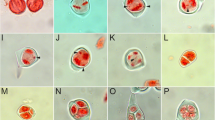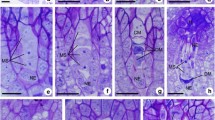Abstract
The present study deals with the cytogenetics of Aponogeton bruggenii S.R.Yadav and Govekar (Aponogetonaceae) sporting asexual propagation. Mitotic metaphase in the root-tips revealed that the species is a polyploid with 2n = 56 chromosomes. Male meiosis was mostly abnormal. A total of 2023 pollen mother cells were observed, of which 448 showed normal and the remaining 1575 abnormal meiosis. Mostly, the stickiness and precocious separation was recorded at diakinesis and metaphase (I and II), respectively. Chromatin bridges, laggards, disorientation, ring formation were detected at various stages of meiosis ranging from diakinesis to telophase. Consequent to chromatin transfer, heterogeneously sized pollen grains, i.e. small, normal, large and fused were observed, hampering gametic efficiency and fruit set. However, the species resorts to vegetative propagation by means of underground tubers, possibly as a survival strategy to sustain dispersion and speciation.
Graphical abstract




Similar content being viewed by others
Data availability
All data generated or analyzed during this study are included in this article. Further inquiries can be directed to the corresponding author.
References
Anis M, Wani AA. Caffeine induced morpho-cytological variability in Fenugreek, Trigonella foenum-graecum L. Cytologia. 1997;62(4):343–9.
Chougule RN, Surveswaran S, George A, Yadav SR, Lekhak MM. Roxburgh was right: Aponogeton microphyllus and Aponogeton undulatus are distinct species. J Biosci. 2023;48:53.
Chougule RN, Surveswaran S, Yadav SR, Lekhak MM. Medicinal potential of the Cape-pondweed family (Aponogetonaceae): a review. S Afr J Bot. 2022;149:994–1007.
Chougule RN, Yadav SR, Lekhak MM. Leaf anatomical studies in Indian Aponogetonaceae. Phytomorphology. 2022;72(3&4):41–54.
Fawcett JA, Maere S, Van de Peer Y. Plants with double genomes might have had a better chance to survive the Cretaceous–Tertiary extinction event. Proc Natl Acad Sci USA. 2009;106(14):5737–42.
Gaikwad SP, Sardesai MM, Yadav SR. Aquatic flowering plants diversity of coastal plains of Konkan, Goa and Karnataka. In: Pullaiah T, editor. Biodiversity in India, vol. 4. New Delhi: Regency Publications; 2002. pp. 89–200.
Kaur D, Singhal VK. Meiotic abnormalities affect genetic constitution and pollen viability in dicots from Indian cold deserts. BMC Plant Biol. 2019;19(1):10.
Koduru PRK, Rao MK. Cytogenetics of synaptic mutants in higher plants. Theor Appl Genet. 1981;59(4):197–214.
Kumar P, Singhal VK, Kaur J. Cytomixis induced meiotic abnormalities in Pollen mother cells of Clematis flammula L. (Ranunculaceae). Cytologia. 2008;73(4):381–5.
Lavania UC. Plant speciation and polyploidy: in habitat divergence and environmental perspective. Nucleus. 2020;63(1):1–5.
Lekhak MM, Yadav SR. Anomalous male meiosis in an aquarium plant, Echinodorus palaefolius (Alismataceae). Nucleus. 2016;59(3):207–10.
Manawaduge CG, Yakandawala D. Morphometric and taxonomic update to the Sri Lankan Aponogetonaceae. Phytotaxa. 2018;365(3):201–24.
Mendes-Bonato AB, Pagliarini MS, do Valle CB, Penteado MIO. A severe case of chromosome stickiness in pollen mother cells of Brachiaria brizantha (Hochst) Stapf (Gramineae). Cytologia. 2001;66(3):287–91.
Nayar TS, Rasiya Beegam A, Sibi M. Flowering plants of the Western Ghats, India. Vol. 2 Monocots. Thiruvananthapuram: Jawaharlal Nehru Tropical Botanic Garden and Research Institute;2014. p. 944.
Rice A, Glick L, Abadi S, Einhorn M, Kopelman NM, Salman-Minkov A, Mayzel J, Chay O, Mayrose I. The Chromosome Counts Database (CCDB)—a community resource of plant chromosome numbers. New Phytol. 2015;206(1):19–26.
Severova EE, Yadav SR, Sokoloff DD. Pollen morphology of Indian Aponogeton (Aponogetonaceae, Alismatales) and the problem of recognizing palynotypes in a taxonomically diverse and ancient genus. Phytotaxa. 2020;475(3):187–200.
Srivastava A, Kapoor K. Seed yield is not impaired by chromosome stickiness in sodium azide treated Trigonella foenum-graecum. Cytologia. 2008;73(2):115–21.
Tantray YR, Singhal VK, Gupta RC. Deciphering the meiotic behaviour in species of genus Artemisia from cold deserts of Ladakh (Jammu and Kashmir). Flora. 2020;262: 151520.
van Bruggen HWE. Monograph of the genus Aponogeton (Aponogetonaceae). Bibl Bot. 1985;33:1–76.
van Bruggen HWE. Aponogetonaceae. In: Kubitzki K, editor. The families and genera of vascular plants, vol. 4. Berlin: Springer-Verlag; 1998. pp. 21–5.
Watve A. Aponogeton bruggenii. The IUCN Red List of Threatened Species 2011: e.T177177A7384396. https://doi.org/10.2305/IUCN.UK.2011-1.RLTS.T177177A7384396.en. Accessed 20 Jan 2024.
Yadav SR. Mechanism of apomixis in Aponogeton decaryi jumelle. Phytomorphology. 1993;43(3&4):201–7.
Yadav SR, Govekar RS. Aponogeton bruggenii (Aponogetonaceae), a new species from India. Rheedea. 1994;4(1):34–6.
Acknowledgements
The authors are thankful to the Head, Department of Botany, Shivaji University, Kolhapur (SUK) for providing the necessary research facilities. RNC thanks DBT, Govt. of India, New Delhi for financial support. SRY is thankful to University Grants Commission (UGC), New Delhi and Indian National Science Academy (INSA), New Delhi for the award of fellowship.
Author information
Authors and Affiliations
Contributions
RNC: Chromosome preparations, writing original draft and preparation of figures. SRY: Conceptualization, review and editing. MML: Conceptualization, writing original draft, review and editing.
Corresponding author
Ethics declarations
Conflict of interest
Authors have no conflict of interest to declare.
Additional information
Publisher's Note
Springer Nature remains neutral with regard to jurisdictional claims in published maps and institutional affiliations.
Corresponding Editor: Umesh C. Lavania: Reviewers: Ahmet L. Tek, Geeta Sharma.
Rights and permissions
Springer Nature or its licensor (e.g. a society or other partner) holds exclusive rights to this article under a publishing agreement with the author(s) or other rightsholder(s); author self-archiving of the accepted manuscript version of this article is solely governed by the terms of such publishing agreement and applicable law.
About this article
Cite this article
Chougule, R.N., Yadav, S.R. & Lekhak, M.M. Asexual propagation could be an escape to sustain the constraints of inefficient gametic system in the evolving endemic species: evidence from meiotic anomalies encountered in Aponogeton bruggenii (Aponogetonaceae). Nucleus (2024). https://doi.org/10.1007/s13237-024-00469-3
Received:
Accepted:
Published:
DOI: https://doi.org/10.1007/s13237-024-00469-3




